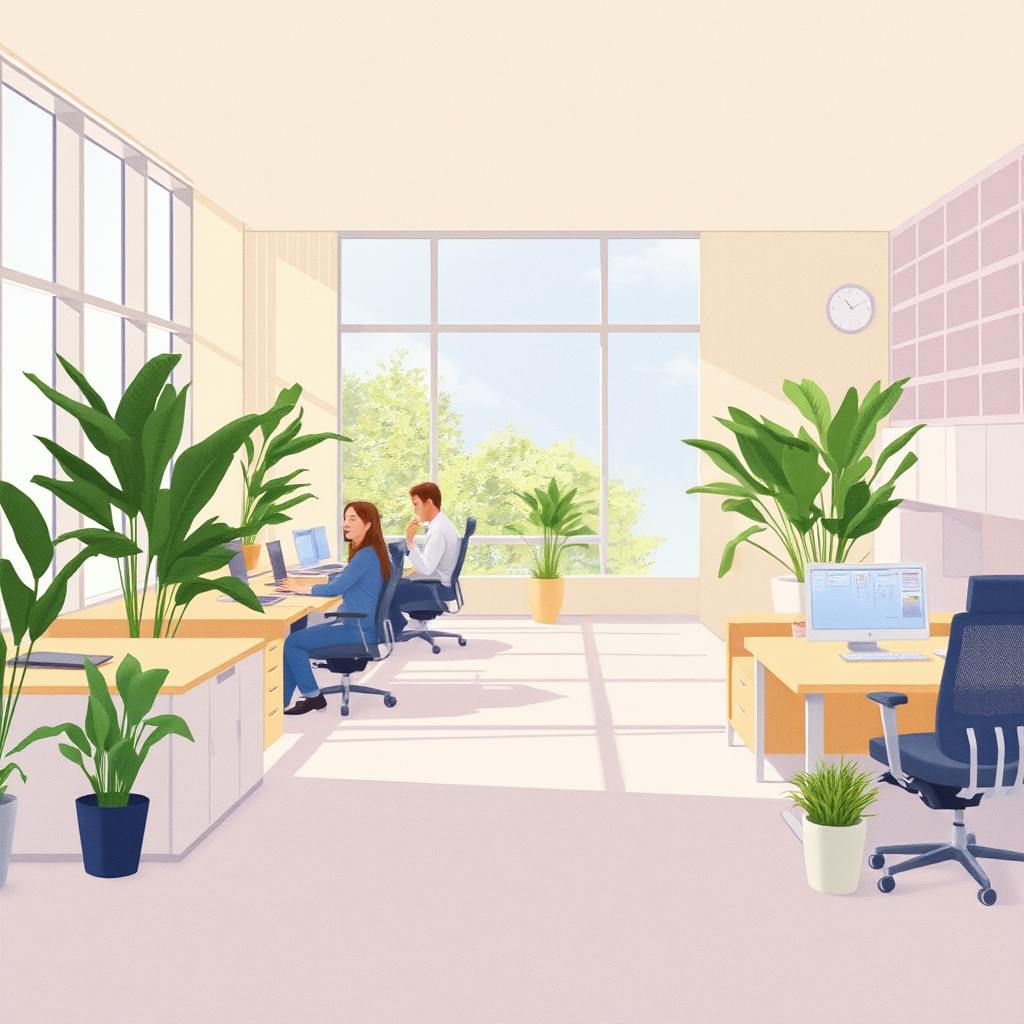The significance of workplace design is becoming increasingly evident. Companies are investing in innovative office layouts and design elements to create environments that not only appeal aesthetically but also enhance functionality. The benefits of workplace design extend beyond mere visual appeal; they encompass improved employee productivity, better office morale, ergonomic office spaces, workplace well-being, and enhanced workplace collaboration. In this article, we will delve into these aspects and explore why an intelligently designed workplace is pivotal for organizational success.
Improved Employee Productivity
Clear and organized workplace design is directly linked to improved employee productivity. An environment that minimizes distractions and promotes focus allows employees to perform tasks more efficiently. For instance, open floor plans can encourage communication and collaboration, reducing time wasted on emails and meetings. However, it's crucial to balance open spaces with private areas for focused work. Noise-reducing elements, such as sound-absorbing panels or quiet zones, further support concentration. With carefully designed spaces, companies can create an atmosphere where work is efficient and deadlines are met, enhancing overall productivity.
Better Office Morale
Workplace design has a strong impact on office morale. A thoughtfully curated office space that reflects a company's values and culture can instill a sense of pride and belonging among employees. Elements like natural lighting, comfortable furniture, and vibrant colors contribute to a positive atmosphere. Such environments make employees feel valued, which in turn boosts morale and reduces turnover rates. Investing in the workplace is synonymous with investing in the workforce; it shows employees that their well-being is a priority, fostering a positive work culture.
Ergonomic Office Spaces
Ergonomic office spaces are a crucial component of effective workplace design. Poorly designed workstations can lead to physical ailments such as back pain, repetitive strain injuries, and eye strain, which can diminish productivity. Ergonomic design focuses on creating work environments that support correct posture, reduce strain, and improve comfort. Adjustable chairs, sit-stand desks, and computer screen extenders can all contribute to a healthier workspace. By prioritizing ergonomics, organizations can significantly reduce absenteeism and enhance employee satisfaction.

AI made with Dean Jones
Workplace Well-being
Workplace well-being extends beyond physical comfort to encompass mental and emotional health as well. Work environments that promote movement, relaxation, and stress relief contribute to overall employee well-being. Incorporating break-out areas, meditation rooms, or fitness zones can provide employees with much-needed respite. Access to green spaces or biophilic design elements—such as indoor plants or nature-inspired aesthetics—can also positively influence mood and stress levels. A happy and healthy employee is invariably a more productive employee, underscoring the value of well-being-centric design.
Enhanced Workplace Collaboration
An office design that facilitates communication and teamwork can significantly enhance workplace collaboration. Spaces designed for agile working, where teams can gather quickly and easily share ideas, are essential for fostering innovation. Meeting pods, brainstorming nooks, and interactive boards are examples of design features that encourage dynamic team interactions. By removing barriers to collaboration, businesses can harness the collective creativity of their workforce, driving innovation and problem-solving.
Commonly Asked Questions About Workplace Design
Why is workplace design so important for businesses today?
Workplace design is important because it directly impacts employee performance, satisfaction, and retention. A well-designed workplace can attract top talent, reduce costs related to absenteeism and turnover, and boost overall organizational performance.
How does workplace design affect company culture?
The design of a workplace reflects a company's culture and values. It can bolster a sense of identity and community among employees, promoting a collaborative and inclusive environment. When the physical space supports the culture, it reinforces the behaviors and attitudes the company wishes to cultivate.
Can workplace design influence innovation?
Yes, workplace design can significantly influence innovation. By creating spaces that encourage collaboration and creative thinking, such as open-plan areas and meeting pods, companies can facilitate the exchange of ideas, which is a catalyst for innovation.
Workplace design is increasingly recognized as a critical factor in enhancing business performance. As a blend of aesthetics, psychology, and functionality, well-thought-out workplace design can significantly influence employee well-being, productivity, and satisfaction. Below, we answer some frequently asked questions about the key benefits of workplace design.
What are the key benefits of a well-designed workplace?
A well-designed workplace offers numerous advantages, such as:
- Enhanced Productivity: Ergonomic furniture and layouts that facilitate efficient workflows can reduce physical strain and distractions, allowing employees to focus better on their tasks.
- Improved Collaboration: Spaces designed for teamwork, such as open-plan areas or dedicated meeting rooms, can foster better communication and collaboration among employees.
- Increased Employee Satisfaction: A workplace that aligns with employee needs can make them feel valued, helping to increase job satisfaction and reduce turnover rates.
- Better Health and Well-Being: Designs that incorporate natural light, plants, and proper ventilation contribute to a healthier work environment, reducing absenteeism and improving mental health.
- Enhanced Company Image: A modern, attractive workspace can enhance a company’s image, impressing clients and aiding in attracting top talent.
Why does workplace design matter for employee productivity?
Productivity is significantly influenced by the work environment. By designing spaces that cater to specific tasks, employees can perform more efficiently:
- Ergonomics: Providing adjustable desks, supportive chairs, and optimal lighting can minimize discomfort and fatigue, which are common productivity barriers.
- Technology Integration: Seamlessly integrating technology into the workspace ensures that employees can work efficiently without unnecessary disruptions.
- Customized Spaces: Allocating quiet zones and breakout areas allows employees to choose environments that suit their work style, whether they need concentration or collaboration.

AI made with Dean Jones
How can a better workplace design improve employee satisfaction?
Employee satisfaction increases when their workspace meets both their professional and personal needs:
- Personalization: Allowing employees to personalize their workstations can make them feel at home and more comfortable, increasing job satisfaction.
- Work-Life Balance: Incorporating amenities like lounges, cafeterias, and wellness rooms can contribute to a better work-life balance by providing employees with opportunities to relax and recharge.
- Inclusion and Accessibility: Designs that consider accessibility needs can make all employees feel equally valued and included, thus boosting morale and satisfaction.
How does workplace design contribute to a company's overall success?
Well-designed workplaces contribute to a company's success in multiple ways:
- Financial Performance: By enhancing productivity and reducing absenteeism, a well-designed workplace can contribute to better financial performance.
- Attracting Talent: A contemporary and thoughtful design can be a powerful tool in attracting top talent who are looking for progressive work environments over traditional setups.
- Corporate Culture and Identity: A workspace that reflects a company’s values and culture can strengthen team coherence and ensure that employees feel aligned with the company's mission.
- Sustainability: Implementing sustainable design practices such as energy-efficient lighting and material selection can positively impact the company’s environmental footprint, appealing to eco-conscious employees and customers.
By prioritizing workplace design, companies not only create a more engaging and healthy work environment but also lay the foundation for long-term success, employee loyalty, and competitive advantage.
Conclusion
The benefits of workplace design are multi-faceted and integral to the success of modern businesses. By focusing on improved employee productivity, better office morale, ergonomic office spaces, workplace well-being, and enhanced workplace collaboration, organizations can create environments that support and motivate their workforce. The investment in workplace design is an investment in a company's most valuable asset: its people. As organizations strive to remain competitive, the strategic design of work environments will play an increasingly pivotal role in shaping their future success.

